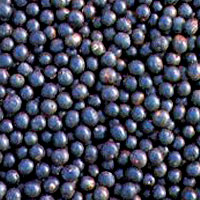Gluten Free
What does following a gluten-free diet mean? That you're embarking on an easy diet with a wide range of health-promoting effects. Instead of dwelling on what you’re giving up, consider that you’re going to enjoy a whole new world of delicious food options to meet your special dietary needs. You’ll be eating seasonally, choosing more fresh fruits and vegetables, focusing on meats, seafood, poultry, legumes, lentils, corn, and rice, and discovering fascinating ancient grains such as quinoa, amaranth, and millet. You’ll be able to eat potatoes, eggs, most cheeses, even chocolate (!)—and enjoy them without guilt because you’ll be taking good care of your body. In fact, you’ll probably end up eating—and feeling—better than ever!
Visit this page for more information about living Gluten Free
---
We carry a large variety of gluten free items, the brands listed below represent just some of the offerings we carry















More Diets
Açaí
 © Steven Foster
© Steven FosterParts Used & Where Grown
Clusters of round, dark purple-to-black, berry-shaped açaí fruits are harvested to make juice, ice pops, and herbal supplements. Ethnobotanists have also documented folk medicine uses for the seed oil, fruit rind, and roots. The inner core of the thin trunk of the açaí tree is well-known as the source of hearts of palm. Açaí is primarily grown in the Pará region of the Amazon estuary, in the northern region of Brazil. It also grows in French Guyana, Panama, Ecuador, and Trinidad.
- Reliable and relatively consistent scientific data showing a substantial health benefit.
- Contradictory, insufficient, or preliminary studies suggesting a health benefit or minimal health benefit.
- For an herb, supported by traditional use but minimal or no scientific evidence. For a supplement, little scientific support.
Our proprietary “Star-Rating” system was developed to help you easily understand the amount of scientific support behind each supplement in relation to a specific health condition. While there is no way to predict whether a vitamin, mineral, or herb will successfully treat or prevent associated health conditions, our unique ratings tell you how well these supplements are understood by the medical community, and whether studies have found them to be effective for other people.
For over a decade, our team has combed through thousands of research articles published in reputable journals. To help you make educated decisions, and to better understand controversial or confusing supplements, our medical experts have digested the science into these three easy-to-follow ratings. We hope this provides you with a helpful resource to make informed decisions towards your health and well-being.
This supplement has been used in connection with the following health conditions:
| Used for | Amount | Why |
|---|---|---|
Metabolic Syndrome | 200 grams of berry pulp daily | Preliminary evidence suggests acai berry may improve metabolic health. |
Anemia | Refer to label instructions | Açaí, which contains small amounts of iron, has been traditionally used to help treat anemia. |
Dysmenorrhea | Refer to label instructions | Açaí is a traditional remedy for dysmenorrhea, and there is preliminary evidence that some anthocyanins found in açaí may help with dysmenorrhea symptoms. |
Fever | Refer to label instructions | Roasted, crushed açaí seeds, consumed as tea, are a traditional remedy for fever. |
Hepatitis | Refer to label instructions | Açaí root tea has been used as a traditional remedy for hepatitis. |
Type 1 Diabetes | Refer to label instructions | Açaí is rich in antioxidants and has been used traditionally to treat diabetes. |
Type 2 Diabetes | 100 grams (about 3 ounces) açai berry pulp or the equivalent daily | Preliminary evidence suggests açai may have benefits in type 2 diabetes. |
Traditional Use (May Not Be Supported by Scientific Studies)
Açaí juice is a major dietary component of Brazilian diets, especially in the Pará region. It is often eaten at breakfast with cassava meal (manioc) or with tapioca and sugar. The açaí fruit is rich in nutrients and is found in many Brazilian prepared foods. The fruit is most popularly used to make juice, but is also found in ice cream, popsicles, and various desserts.
Açaí seeds can be crushed to produce a green oil that has been used as a folk remedy for scrofula (a type of tuberculosis). The roasted, crushed seeds, consumed as tea, are a traditional remedy for fever. Tea made from the root is a folk remedy for jaundice and anemia. Tea made from the grated fruit rind has been used topically as a wash for skin ulcers. Boiled preparations of açaí root have been used traditionally to treat many diseases, including diabetes, hepatitis, malaria, kidney disease, and dysmenorrhea (menstrual pain).
No clinical trials of açaí for the prevention or treatment of any health condition have been published in the medical literature.
Copyright © 2024 TraceGains, Inc. All rights reserved.
Learn more about TraceGains, the company.
The information presented by TraceGains is for informational purposes only. It is based on scientific studies (human, animal, or in vitro), clinical experience, or traditional usage as cited in each article. The results reported may not necessarily occur in all individuals. Self-treatment is not recommended for life-threatening conditions that require medical treatment under a doctor's care. For many of the conditions discussed, treatment with prescription or over the counter medication is also available. Consult your doctor, practitioner, and/or pharmacist for any health problem and before using any supplements or before making any changes in prescribed medications. Information expires December 2024.











